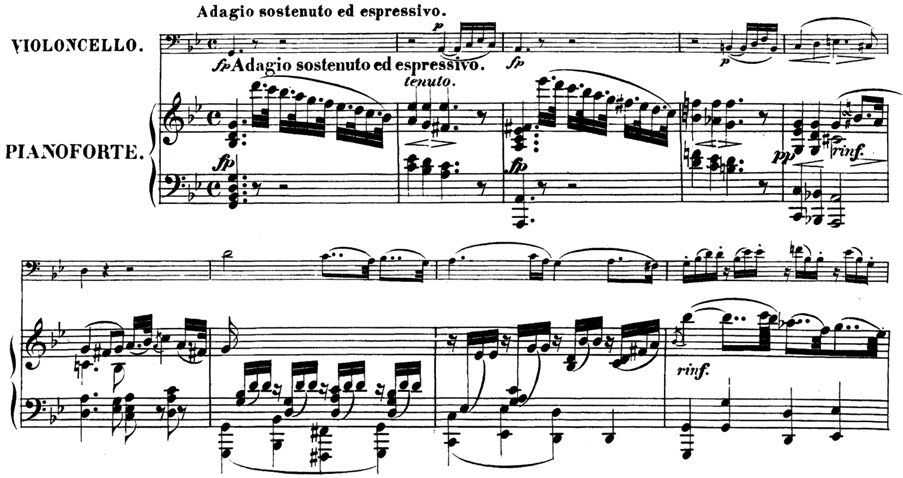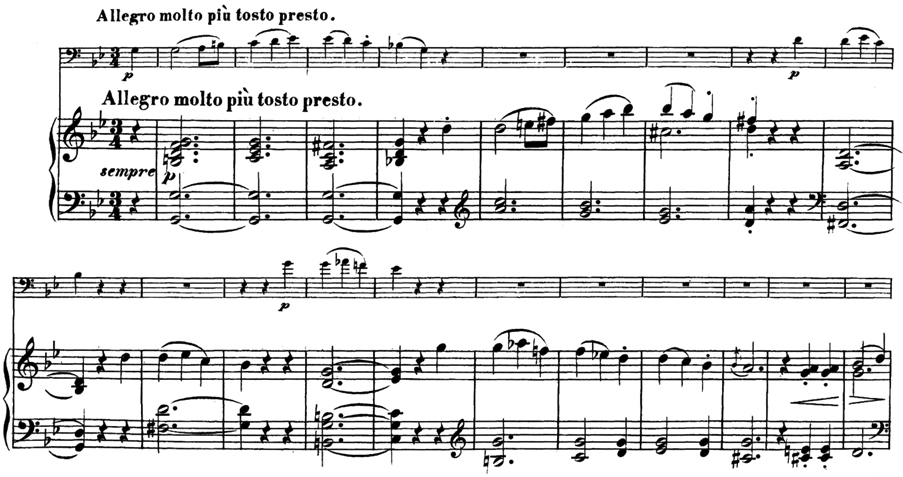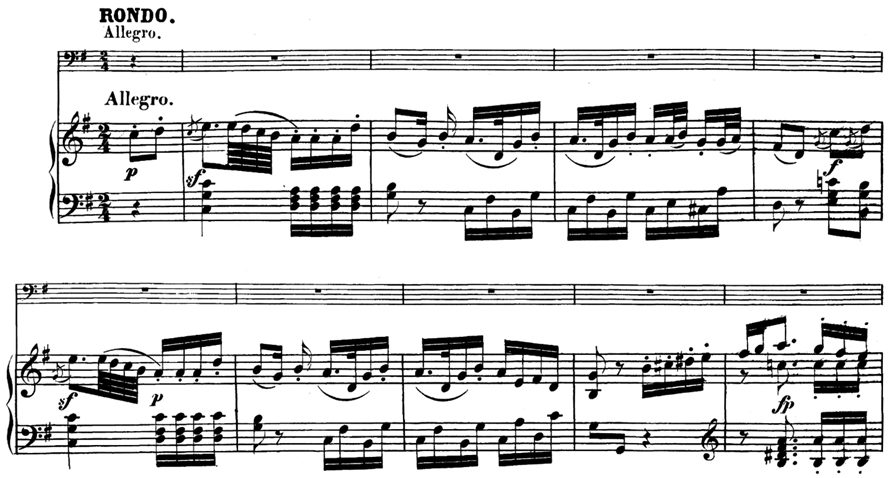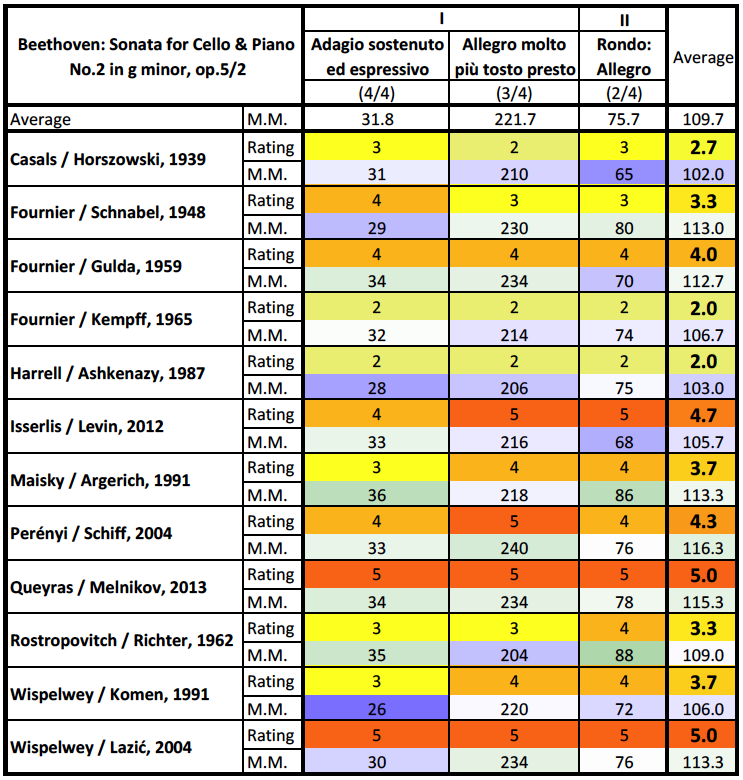Ludwig van Beethoven
Sonata for Piano and Cello in G minor, op.5/2
Media Review / Comparison
2017-08-14 — Original posting
Table of Contents
- Introduction
- The Recordings
- Background, About the Composition
- The Interpretations, Overview
- The Interpretations in Detail
- Pablo Casals and Mieczysław Horszowski (1939)
- Pierre Fournier and Artur Schnabel (1948)
- Pierre Fournier and Friedrich Gulda (1959)
- Pierre Fournier and Wilhelm Kempff (1965)
- Lynn Harrell and Vladimir Ashkenazy (1987)
- Steven Isserlis and Robert Levin (2012)
- Mischa Maisky and Martha Argerich (1991)
- Miklós Perényi and András Schiff (2001/2002)
- Jean-Guihen Queyras and Alexander Melnikov (2013)
- Mstislav Rostropovich and Sviatoslav Richter (1962)
- Pieter Wispelwey and Paul Komen (1991)
- Pieter Wispelwey and Dejan Lazić (2004)
- Conclusions
- Addendum
Introduction
This is another note on the recordings of Beethoven’s sonatas for piano & cello in my music collection, about the Sonata in G minor, op.5/2 — references to the CDs are given at the bottom of the respective section, or see the summary on the postings covering Beethoven’s Sonatas for Piano & Violoncello.
The Recordings
Below you find my comments on the recordings that I have for the Sonata for Piano and Cello in G minor, op.5/2 (references to the recordings are given in each section). Here’s a short list of the recordings in this comparison, in alphabetic order (last name of the cellist):
- 1939: Pablo Casals & Mieczyslaw Horszowski
- 1948: Pierre Fournier & Artur Schnabel
- 1959: Pierre Fournier & Friedrich Gulda
- 1965: Pierre Fournier & Wilhelm Kempff
- 1987: Lynn Harrell & Vladimir Ashkenazy
- 2012: Steven Isserlis & Robert Levin
- 1991: Mischa Maisky & Martha Argerich
- 2001/2002: Miklós Perényi & András Schiff
- 2013: Jean-Guihen Queyras & Alexander Melnikov
- 1962: Mstislav Rostropovich & Sviatoslav Richter
- 1991: Pieter Wispelwey & Paul Komen
- 2004: Pieter Wispelwey & Dejan Lazić
Background, About the Composition
Ludwig van Beethoven (1770 – 1827) wrote his Sonata for Piano and Cello in G minor, op.5/2 at the same time as the companion sonata in F major, op.5/1, i.e., in 1796, while the composer was in Berlin; the sonatas are dedicated to the King of Prussia Friedrich Wilhelm II, but apparently, they were premiered by Beethoven at the piano, with the cello being played by either Jean-Pierre Duport or his brother, Jean-Louis Duport. Allegedly, the sonatas op.5 were the first cello sonatas with fully written-out piano part (as opposed to a basso continuo).
The Movements
Beethoven’s Sonata for Piano and Cello in G minor, op.5/2 has two movements (or three, if the Adagio sostenuto ed espressivo is taken as a separate movement):
I. Adagio sostenuto ed espressivo (4/4) — Allegro molto più tosto presto (3/4)
As already in the first sonata, Beethoven starts with a slow introduction (or movement, if you like). However, this introduction is entirely different in character, even though both use punctuated motifs at some point. In accordance with the G minor tonality, the Adagio sostenuto ed espressivo in op.5/2 is earnest. Initially vague in the atmosphere, and without real tension or outlook, the character is not just determined by the minor tonality, but also by the punctuated downward scales and chord sequences.
Things brighten up a bit, once more melodic elements start to take room, the tone turns more confident, and Beethoven prepares for the subsequent Allegro molto più tosto presto:
The Allegro molto più tosto presto follows attacca:
The Allegro molto più tosto presto is in the form of a sonata movement, exposition and also development/recapitulation parts have repeat signs. The movement concludes with a 72-bar Coda. “Rolling” quaver triplets dominate the piano part, while the cello “cultivates” its own themes. The first one of these appears in the initial bars, as shown above.
II. Rondo: Allegro (2/4)
The Rondo is not in G minor, but in G major—a joyful, light-hearted theme, contrasting to the atmosphere in the first movement:
Throughout the movement, one can see that Beethoven wrote the piano part for himself: for its time, this is fairly virtuosic!
The Interpretations, Overview
In order to provide a rating overview, as well as an idea about tempo relations both within an interpretation, as well as between the two recordings, I have prepared the table below. The color coding for the tempo (blue = slower, green = faster) refers to the average between the recordings:
Note that the metronome rates are approximate. All metronome values were evaluated based on crotchets (even though in practice, the fast part of the first movement is counted in entire bars).
The Interpretations in Detail
All of the recordings below are part of complete sets, covering all Beethoven cello sonatas; most of them also include some or all of the variation sets, two include the sonata op.17, originally written for horn and piano.
Pablo Casals and Mieczysław Horszowski (1939)
Beethoven: The Sonatas for Cello & Piano; Variations WoO 46; Minuet in G, WoO 10/2
Pablo Casals & Mieczysław Horszowski
Otto Schulhof, Alfred Cortot
Allegro / The Great Performers, CDO 4005 (2 CDs, mono); © 2001
Booklet: 4 pp. english

For details / general information on the artists see my posting “Beethoven: Cello Sonata in A major, op.69“. This recording was made in 1936. Here (as in all sonatas, except op.69), Pablo Casals (1876 – 1973) plays with Mieczysław Horszowski (1892 – 1993).
I. Adagio sostenuto ed espressivo — Allegro molto più tosto presto
Duration: 5’36” + 7’48”
The slow introduction gives a clear testimony of Casals’ “percussive” bow & articulation: every tone begins with a “T” (as one of my former violin teachers would quote), and even in legato / slurred figures, every note tends to have a little accent to it. Needless to say that there are no signs of “Nachdrücken” (i.e., ending long notes with a brief crescendo when trying to reach the end of the bow), and the recording exposes Casals’ intense, dense tone. Understandably, the sound (mono, of course) is somewhat focused on the cello. So, occasionally, the piano tends to hide behind the cello. I regard it a little shortcoming that the performance builds up little, if any tension prior to last bar (#28)with the demisemiquaver triplets in the piano: up to there, it is fairly static.
In the Allegro part, Casals’ playing is very differentiated in dynamics: he forms little arches from every phrase, even in single motifs. On the downside, there are some slight superficialities, occasional coordination shortcomings, where the pianist not always is able to follow Casals’ impulsive agogics. The performance is even occasionally dragging. Overall, clearly (from what transpires through this mono recording), the shaping power is with the cello, not the piano. No repeats are performed.
II. Rondo: Allegro
Duration: 9’37”
Clearly, it’s Casals who drives, who “runs” this performance, even though the piano part is not bad at all: the cello sets the pace, controls rubato, the attack, the mood, the atmosphere. Casals’ playing is powerful, often vehement (and always percussive!). He always uses very clear articulation. The piano occasionally lags behind a tiny bit—though one should note that occasionally, in his impulsive playing, Casals is pulling ahead, and in these early recordings, this could hardly be corrected (other than by repeating the recording of a movement). In the same vein, the ending isn’t entirely harmonious between the two artists.
| Duration: | 22’59” |
| Recommendation: | Definitely—as expected—a historic document, giving testimony of Casals’ playing philosophy. |
| Rating: | 2.7 (3 / 2 / 3) |
Pierre Fournier and Artur Schnabel (1948)
Beethoven: The Sonatas for Cello & Piano; Schubert: 6 Moments Musicaux op.94, D.780
Pierre Fournier & Artur Schnabel
Andromeda, ANDRCD 5108 (2 CDs, mono); ℗ 2007
Booklet: 4 pp. (track listing only)

For details / general information on the artists see my posting “Beethoven: Cello Sonata in A major, op.69“.
I. Adagio sostenuto ed espressivo — Allegro molto più tosto presto
Duration: 13’20” (1 track, 6’32” + 6’48”)
In comparison with Casals, the most striking differences in the introduction are the distinctly slow (it definitely feels too slow!), and Fournier’s sumptuous, intensely singing tone, with generous, pretty ubiquitous vibrato. It’s certainly nice initially, but in my view tends to wear off after a while, particularly at this slow pace. Fortunately, there is Schnabel’s strong accompaniment, always consciously shaped, forming harmonious counterpoints to the cello, helping to build tension over the entire introduction (better than Casals / Horszowski, actually).
In contrast, the Allegro part is faster than Casals’, above the average tempo: at this pace, the accompaniment occasionally feels a bit summary. On the other hand, the coordination is flawless. One can sometimes feel that Schnabel is driving the tempo. No repeats are performed.
II. Rondo: Allegro
Duration: 8’01”
It seems that Schnabel was the driver in this movement: in “typical Schnabel manner”, the piano starts at a very fast pace, then even accelerates, keeps pushing throughout the movement. Schnabel is chasing the cello forward, ignoring superficialities in his own part. Fournier keeps up amazingly well. Still, this feels more like an Presto, rather than Allegro. There are many other examples where Schnabel firmly sticks to his tempo concept, irrespective of occasional “losses”, such as inaccuracies, superficialities, the need to push or pull, in order to maintain the pace. This leaves me a bit breathless, even though it is an impressive performance.
| Duration: | 21’20” |
| Recommendation: | Definitely a valuable, precious historic document — for the Schnabel community and those interested in this artist’s playing. |
| Rating: | 3.3 (4 / 3 / 3) |
Pierre Fournier and Friedrich Gulda (1959)
Beethoven: The Sonatas for Cello & Piano; Variations WoO 45, 46, op.66
Pierre Fournier & Friedrich Gulda
IDG 00289 477 6266 (2 CDs, stereo); ℗ 1960 / © 2006
Booklet: 24 pp. e/d/f

For details / general information on the artists see my posting “Beethoven: Cello Sonata in A major, op.69“.
I. Adagio sostenuto ed espressivo — Allegro molto più tosto presto
Duration: 12’17” (1 track, 5’05” + 7’12”)
This recording—11 years later—offers substantially more transparency. That’s not just because of the stereo technique, but also the superior sound capture in general. The introduction is among the fastest (!), and already in the punctuated motifs in the first bars, one can feel Gulda’s clear, strongly articulating, consciously shaping handwriting. Fournier’s punctuations occasionally are a tad softer than Gulda’s—a deliberate choice, e.g., above the demisemiquaver triplet accompaniment. Overall, an expressive, even dramatic interpretation, in which one cannot complain about a lack of tension!
In the Allegro part, Fournier can certainly keep up with Gulda’s fast pace (among the fastest here), but the tempo certainly suits Gulda better than the cellist, who can’t be nearly that detailed in articulation and phrasing. No repeats are performed.
II. Rondo: Allegro
Duration: 9’00”
Good tempo, not too fast, for sure. Already the piano introduction gives testimony of Gulda’s clear articulation, his excellent control in tempo and dynamics and rhythmic flexibility: as already with Schnabel, the piano appears to dominate here—though, that clearly can—maybe mostly—be attributed to Beethoven’s piano part. Still, there are segments where also Fournier is “speaking up”; the coordination and the playing in general are excellent.
One minor quibble: towards the end, there are a couple “mono moments”, and in one short moment, the cello appears to switch to the other side—these must be re-mastering artifacts.
| Duration: | 21’17” |
| Recommendation: | Even though “conventional” in concept, I really like Gulda’s “handwriting” here, and Fournier must have been at the height of his artistic abilities. Recommended! |
| Rating: | 4.0 (4 / 4 / 4) |
Pierre Fournier and Wilhelm Kempff (1965)
Beethoven: The Sonatas for Cello & Piano; Variations WoO 45, 46, op.66
Pierre Fournier & Wilhelm Kempff
DG 453 013-2 (2 CDs, stereo); ℗ / © 1966
Booklet: 28 pp. e/d/f/i/sp

For details / general information on the artists see my posting “Beethoven: Cello Sonata in A major, op.69“.
I. Adagio sostenuto ed espressivo — Allegro molto più tosto presto
Duration: 13’00” (1 track, 5’25” + 7’35”)
Compared to Fournier’s earlier recordings, the articulation has softened considerably—in general, and in both parts, actually. Kempff’s punctuations are not always as sharp as with others. Occasionally, he shows a tendency to be slightly ahead of the beat, which reinforces the impression of a mellow, somewhat “washed out” interpretation. In the same vein, the performance lacks some tension, and the sound management is inferior to the recording with Gulda.
Also in the Allegro part, the articulation is too mellow, some staccati in the cello barely recognizable as such. It’s also not aggressive enough for the “più tosto presto” annotation, even though Kempff makes efforts in freshening up the dynamics. No repeats are performed.
II. Rondo: Allegro
Duration: 8’49”
This is a tad faster than the recording with Gulda—but at the same time, Kempff exhibits a slight tendency to pull forward, which creates a certain unrest. Much less refined and clear than the recording with Gulda. Occasionally, the articulation (primarily in the cello) is somewhat sloppy (broad staccato, for example).
| Duration: | 21’49” |
| Recommendation: | Doesn’t come close to Fournier’s earlier recordings: I can’t recommend this. |
| Rating: | 2.0 (2 / 2 / 2) |
Lynn Harrell and Vladimir Ashkenazy (1987)
Beethoven: The Sonatas for Cello & Piano
Lynn Harrell & Vladimir Ashkenazy
Decca / London 417 628-2 (2 CDs, stereo); ℗ / © 1987
Booklet: 39 pp. e/f/d

For details / general information on the artists see my posting “Beethoven: Cello Sonata in A major, op.69“.
I. Adagio sostenuto ed espressivo — Allegro molto più tosto presto
Duration: 5’53” + 10’54”
Very slow (one of the slowest performances here, throughout the first movement), felt in quavers rather than crotchets. Harrell’s vibrato is strong, rather nervous, and he frequently uses portamento—too frequently, in my view, such as to become a mannerism. The descending punctuations feel very mellow. Some drama only evolves around the ff in bar 21—but even there, it does not last, remains episodic, interspersed with calm, serene segments.
Also the Allegro molto part feels on the slow side, rather like an Andante, if felt in entire bars. Yes, it is expressive, but rather heavy at times, and the artists tend to soften the articulation, some details in the piano part feel a tad superficial. Occasionally, the momentum seems to get lost. On the bright side: the first part (exposition) is repeated.
II. Rondo: Allegro
Duration: 8’12”
Ashkenazy drives the movement, feels agile, never slow, articulation and dynamics are very good, showing off the piano virtuoso. The cello can’t really compete with this, in terms of acoustic presence, in “drive” (he does keep up well, though), and in articulation, which often is somewhat superficial. This just demonstrates how very demanding this movement is! In this performance, the cello largely appears limited to an accompanying / illustrative function. The piano part alone would deserve a better rating—but what counts here is the overall outcome.
| Duration: | 24’57” |
| Recommendation: | Somewhat of a disappointment, overall. |
| Rating: | 2.0 (2 / 2 / 2) |
Steven Isserlis and Robert Levin (2012)
Beethoven: The Sonatas for Cello & Piano, incl. op.17; Variations WoO 45, 46, op.66
Steven Isserlis & Robert Levin
hyperion CDA67981/2 (2 CDs, stereo); ℗ / © 2014
Booklet: 24 pp. e/f/d

For details / general information on the artists see my posting “Beethoven: Cello Sonata in A major, op.69“. This is a recent recording, with Steven Isserlis (*1958), accompanied by Robert Levin (*1947). Isserlis plays a cello by Stradivarius, “Marquis de Corberon”, from 1726, and a Tourte bow; Levin plays a fortepiano by Paul McNulty — a replica after an instrument by Walter & Sohn from around 1805. Note that the tuning pitch here is slightly below that of current instruments. In direct comparisons with modern recordings, this may initially sound irritating. It pays to adapt to the old pitch before really listening into this recording.
I. Adagio sostenuto ed espressivo — Allegro molto più tosto presto
Duration: 5’20” + 14’13”
The Walter fortepiano
This instrument is much more appropriate for this sonata than Paul Komen’s Broadwood (in Wispelwey’s early recording, see below), even though the design is 9 years younger than the sonata: Beethoven was always interested in advancements in piano construction and possibilities, so he would certainly have welcomed this instrument. Also, this is a replica, rather than a true period instrument. One can assume that the sound is close to the original—but the mechanics are a replica, too, hence new / unspoiled by time & use. The primary advantage of this model (over the Broadwood) is in its singing sound, the richness in colors, the transparency, the amount of differentiation and detail.
Adagio sostenuto ed espressivo
After the initial fp chord, the descending piano line sounds a little too harmless (where’s the espressivo?). Levin explores the instrument up to its limits, if not a tad beyond, e.g., in ff passages in the descant (e.g., in bar 21), the intonation is clearly starting to suffer. But otherwise, I really like the sound, the detail, the articulation. Isserlis uses vibrato sparingly (a little more than Queyras, though)—mainly to make cantilenas, melodies blossom. But often, there is no vibrato at all—but throughout the movement, there’s Isserlis’ expressive articulation and phrasing. If there are slight tempo variations, these are clearly deliberate, diligent agogics. And the interpretation definitely builds up tension towards the fast part.
I particularly like the use of the moderator in the last bar (43): this makes the fortepiano sound darker, softer, and more mellow: just what’s needed to make the movement fade away before the Allegro part starts. In general, with this instrument, the focus (in comparison) is more on the cello, even though with the bright, singing quality of the Walter instrument, the accompaniment cannot be ignored, keeps its presence, the performance always remains very transparent.
Allegro molto più tosto presto
Here, the Walter fortepiano can play out its true strengths: the almost ubiquitous quaver triplets appear crystal-clear, light and effortless. Articulation and phrasing are excellent, with nice agogic play. The artists observe both repeats, whereby particularly in the second pass some extra ornaments are added (in both instruments), very well and diligently shaped and positioned. It’s an interpretation from a single mind, a single mold. I particularly like the idea of a (very short) piano cadenza in the second pass at the fermata in bar 378. Simply excellent, really!
II. Rondo: Allegro
Duration: 9’16”
The Walter fortepiano takes away some of the drama, or reduces its scale—which is perfectly OK, because at that time, Beethoven could not have anticipated the volume and power of a modern concert grand, even of a Broadwood instrument. But once one is “in” the interpretation, one can certainly find just as much detail in articulation and dynamics as with the top interpretations on modern instruments. In terms of lightness and agility, the Walter instrument certainly beats any other instrument in this comparison—even more so in the colors, of course. An in terms of acoustic balance, this is as close to how this must have sounded at Beethoven’s time as humanly possible. The tempo here is moderate, definitely feels very natural, not stressed / pushed: Allegro, not Presto!
| Duration: | 28’47” |
| Recommendation: | In my view, among the very best recordings available, strongly recommended, and on a par with Queyras / Melnikov and Wispelwey / Lazić, in terms of richness of the listening experience. |
| Rating: | 4.7 (4 / 5 / 5) |
Mischa Maisky and Martha Argerich (1991)
Beethoven: The Sonatas for Cello & Piano; Variations WoO 45, 46, op.66
Mischa Maisky & Martha Argerich
DG 453 748-2 (2 CDs, stereo); ℗ 1991/93 / © 1997
Booklet: 46 pp. e/d/f

For details / general information on the artists see my posting “Beethoven: Cello Sonata in A major, op.69“.
I. Adagio sostenuto ed espressivo — Allegro molto più tosto presto
Duration: 5’27” + 9’42”
Vivid in the detail, though tending to give in to the tension—an occasional tendency to let the tempo run faster, which to me is detrimental to the overall impression (while in a live performance, this may work just fine). Certainly, Martha Argerich is always alert, as we expect from this artist. Maisky’s vibrato is fairly strong and ubiquitous, but at least not excessively nervous. Overall, even though lively and often dramatic, the performance seems to lose tension towards the end.
Here, the focus is on drama and expression, rather than articulative detail. The impetus and the momentum are largely driven by Martha Argerich. Impulsive and full of life, down to small motifs, and she pays attention to “hidden” secondary voices in rapid passagework. But also here, on a small scale, there is the occasional tendency to accelerate, especially in the piano part. The exposition is repeated.
II. Rondo: Allegro
Duration: 7’37”
Almost as fast as Rostropovich / Richter, but vastly more lively in articulation and detail. Excellent playing, though the fast pace can only be maintained by occasional pushing / picking up a faster pace, and through sometimes rushed articulation. In general, though, the articulation is clear and flawless, and also coordination is not an issue: the artists understand each other very well. Amazing performance, technically, in tempo and articulation (typical of Argerich!)—but does it have to be that fast, always that active? Olympic, as Richter / Rostropovich.
| Duration: | 22’46” |
| Recommendation: | Definitely an excellent performance, not just for fans of Martha Argerich |
| Rating: | 3.7 (3 / 4 / 4) |
Miklós Perényi and András Schiff (2001/2002)
Beethoven: The Sonatas for Cello & Piano, incl. op.17; Variations WoO 45, 46, op.66
Miklós Perényi & András Schiff
ECM New Series 1819/20 (2 CDs, stereo); ℗ / © 2004
Booklet: 28 pp. d/e

For details / general information on the artists see my posting “Beethoven: Cello Sonata in A major, op.69“.
I. Adagio sostenuto ed espressivo — Allegro molto più tosto presto
Duration: 5’08” + 13’02”
The tempo in the slow introduction isn’t too slow (slightly above average)—strangely, Schiff softens the punctuations—almost as if they were triplets (semiquaver + demisemiquaver). In general, the focus is on the cantilenas, the singing, and Perényi certainly exhibits a beautiful, singing tone, with natural, not excessive vibrato. Also Schiff’s piano tone is excellent, from the descant down to the sonorous basses. Serene, singing rather than dramatic—with few exceptions in the ff climaxes.
The latter points also apply to the Allegro molto part, played at a very fluent pace (the fastest version here), with a slight focus on the big phrases rather than on details in the articulation in small motifs (at least in the exposition). Smooth playing, careful dynamics (also down to small motifs, and also in the balance between the two hands on the piano), following the big phrases / arches. The focus in this performance / recording seems to be on the piano, which to me stands out in terms of articulative and dynamic detail. Expectedly, both repeats are observed. The longer the movement lasts, the more detail / qualities the piano part seems to exhibit, down to small-scale details. Excellent!
II. Rondo: Allegro
Duration: 8’33”
Expectedly, Schiff & Perényi are diligent in their tempo selection. Excellent, detailed and clean in articulation, coordination and dynamics—maybe to the point where it starts to feel academic. Good, excellent—but not at the very top in this comparison.
| Duration: | 26’42” |
| Recommendation: | A very good recording, occasionally even excellent / top |
| Rating: | 4.3 (4 / 5 / 4) |
Jean-Guihen Queyras and Alexander Melnikov (2013)
Beethoven: The Sonatas for Cello & Piano; Variations WoO 45, 46, op.66
Jean-Guihen Queyras & Alexander Melnikov
Harmonia mundi HMC 902183.84 (2 CDs, stereo); ℗ 2014
Booklet: 20 pp. f/e/d

For details / general information on the artists see my posting “Beethoven: Cello Sonata in A major, op.69“. Queyras plays a cello by Gioffredo Cappa from 1696, Melnikov plays a modern concert grand.
I. Adagio sostenuto ed espressivo — Allegro molto più tosto presto
Duration: 18’17” (1 track, 5’21” + 12’56”)
Queyras uses even less vibrato than Wispelwey: none at all at the beginning of the introduction, then subtly controlled in the cantilena, just enough to make the melody sing. At the beginning, this creates a particular, bleak atmosphere. Good tempo, excellent articulation: both musicians appear balanced in presence and articulation. The general rests in the last bars are extra long—yet anything but dead: one can almost touch the tension that is building up towards the Allegro molto più tosto presto! Notably, the tension build-up is not achieved with excess activity. Rather, the artists use carefully crafted dynamics in long arches, and a return to the bleak mood of the beginning, which makes those general rests appear even more empty!
Allegro molto più tosto presto
In the Allegro molto part, I particularly liked the detailed, careful articulation, carefully coordinated between the artists—playing with one soul: I like the permanent dialog, the interplay between the instruments! Melnikov often uses a very slightly arpeggiated touch in the right hand, which helps the transparency and is absolutely in line with how fortepianos of the period must have been played, as a crystal-clear, 100% synchronous touch is hardly achievable on these instruments. Melnikov also avoids over-articulating the quaver triplets: these are indeed secondary / accompaniment only.
Both repeats are observed. The artists also play with agogics & tempo: the development part starts slightly (but noticeably) faster, and the second pass of that part increases the pace yet again. In addition, Melnikov adds the occasional extra ornament, very fittingly placed and crafted. Some details: while the quaver triplets always remain ornaments / passagework, quaver figures such as those after the fermata in bar 378 are very carefully and exquisitely articulated. In the first pass, the first fermata in bar 378 is arpeggiated, in the faster second pass it is kept simple. In contrast, in that second pass (only), the shifted octave cascade in bars 425ff. appears hemiolic, i.e., with an extra accent on the first note in every descending third step in the left hand: a nice idea!
II. Rondo: Allegro
Duration: 8’14”
A tad faster than Wispelwey / Lazić and Perényi / Schiff. Not nearly as elaborate in the details as the former, nevertheless very carefully shaped and articulated, down to the level of motifs—yet never academic. Just natural and playful, also in its virtuosity, expansive in the dynamics—outstanding! And another performance from a single mind / soul / mold!
| Duration: | 26’29” |
| Recommendation: | Maybe slightly less sophisticated and detailed than Wispelwey / Lazić — nevertheless among the very top recordings of this sonata, strongly recommended! |
| Rating: | 5.0 (5 / 5 / 5) |
Mstislav Rostropovich and Sviatoslav Richter (1962)
Beethoven: The Sonatas for Cello & Piano
Mstislav Rostropovich & Sviatoslav Richter
Philips 412 256-2 (2 CDs, stereo); ℗ 1963
Booklet: 11 pp. e/d/f

For details / general information on the artists see my posting “Beethoven: Cello Sonata in A major, op.69“.
I. Adagio sostenuto ed espressivo — Allegro molto più tosto presto
Duration: 19’57” (1 track, 5’15” + 14’42”)
It’s a stereo recording, but the sound quality in general is rather modest, somewhat dull. As for the annotation of the introduction: it’s definitely espressivo—but I fail to see the sostenuto aspect. Rather, it’s vehement, sometimes pushing forward (besides Maisky / Argerich, it’s the fastest introduction in this comparison). There are also lyrical segments (sometimes close to losing tension)—these increase the feeling of excess pushing forward in the more dramatic sections.
The beginning of the Allegro molto più tosto presto part (all marked p) feels rather comfortable—to much for “più tosto presto“. Indeed, it’s one of the slower tempos in this comparison. The f parts are certainly dramatic: it seems that the two artists are substituting expression and drama for the presto aspect. There are even moments where motifs sound almost clumsy, such as some of those repeated quavers (e.g., bars 54/55). Technically flawless, of course—yet, not their strongest interpretation, I think (or an aging interpretation?). On the bright side: both repeats are observed.
II. Rondo: Allegro
Duration: 7’15”
While the fast part in the first movement was the slowest sample in this comparison, here, the artists are faster than anybody else. The fast pace seems OK from the Allegro with 2/4 time signature, and the artists—masters of their time, technically—leave the listener in awe of their virtuosity. However, that tempo leaves very little opportunity for differentiation and detail, and larger-scale phrasing and dynamics dominate over small-scale agogics and articulation. And it feels faster than Allegro. Still, an olympic performance!
| Duration: | 27’12” |
| Recommendation: | A “classic” recording with two stellar artists. However, time goes on, the HIP performances have now influenced also “conventional” artists, so this performance starts to fall behind. It definitely is behind technically, in the sound, unfortunately. |
| Rating: | 3.3 (3 / 3 / 4) |
Pieter Wispelwey and Paul Komen (1991)
Beethoven: The Sonatas for Cello & Piano
Channel Classics CCS3592 (2 CDs, stereo); ℗ / © 1992
Booklet: 20 pp. e/nl/d/f

For details / general information on the artists see my posting “Beethoven: Cello Sonata in A major, op.69“. Paul Komen is playing a historic Broadwood fortepiano from 1823 (the same instrument model that Beethoven received from Broadwood in 1818 as a gift, on behalf of Muzio Clementi). Pieter Wispelwey plays a Cello by Barak Norman from 1710. Note that the tuning pitch here is slightly below that of current instruments. In direct comparisons with modern recordings, this may initially sound irritating. It pays to adapt to the old pitch before really listening into this recording.
I. Adagio sostenuto ed espressivo — Allegro molto più tosto presto
Duration: 6’13” + 14’12”
Using a Broadwood fortepiano?
The Broadwood instrument is actually “too modern” for this sonata, which was composed 1796, 27 years before this instrument was built. Yes, it has the bigger sound than an instrument from the turn of the century (such as a Walter fortepiano), but then, it is also known as having a rough, often noisy, coarse sound. With a historic instrument, this recording was also done with historic mechanics, which—albeit revised / restored—are less precise than those of modern instruments, hence the touch typically sounds like slightly arpeggiando. Another peculiarity with the Broadwood instruments is in their short felt dampers, which have limited effect, especially if actuated after ff chords.
Adagio sostenuto ed espressivo
The Broadwood instrument lives up to its reputation: big volume (for a fortepiano, that is), definitely with “singing” quality in the descant, but primarily relatively rough, lacking differentiation. Certainly, the instrument has no problem withstanding the sound of the cello. The tempo is too slow, the interpretation (especially in the piano accompaniment) often very static. Possibly a consequence of the slow pace, the tempo occasionally tends accelerate slightly. To me, this does not feel like deliberate, feels a bit odd. The damper limitations also are slightly detrimental to the effect of rests.
Wispelwey uses slightly more vibrato than in his newer recording—that’s probably needed at this slow pace. But more than the piano sound, my primary objection here is that the movement is completely static (except for the odd tempo excursions), hence often lacks tension and perspective.
Allegro molto più tosto presto
Here, the tempo is definitely more natural, and there are fewer “spontaneous accelerandi”. Accents stand out nicely, although—as mentioned—coarse in sound. Overall, the balance between the instrument is good, as is the transparency—just a bit more differentiation & subtlety would be nice! On the positive side: both repeats are performed, though with little, if any variation.
II. Rondo: Allegro
Duration: 8’49”
One of the slower performances, but definitely OK in the tempo. Here, the Broadwood appears in a somewhat more favorable light: it can play out its agility, the singing in the descant, and the bass does not reach into the “noisy domain”. It’s still preferable over a modern grand—at least in live performances, where a Steinway is notoriously oppressing the cello, unless the lid is closed (which affects the sound quality) and unless it is played very diligently. Of course, Wispelwey’s playing is flawless and closely in tune with the fortepiano—nothing to complain there as well.
| Duration: | 29’13” |
| Recommendation: | From its characteristics, I would classify this as “early historically informed recording”, which can’t really compete with current HIP performances (mainly because it’s the “wrong” piano!). Interesting, but… |
| Rating: | 3.7 (3 / 4 / 4) |
Pieter Wispelwey and Dejan Lazić (2004)
Beethoven: The Sonatas for Cello & Piano; Variations WoO 45, 46, op.66
Pieter Wispelwey and Dejan Lazić
Channel Classics CCS SA 22605 (2 CDs, stereo); ℗ / © 2005
Booklet: 20 pp. e/nl/f/d

For details / general information on the artists see my posting “Beethoven: Cello Sonata in A major, op.69“.
I. Adagio sostenuto ed espressivo — Allegro molto più tosto presto
Duration: 5’54” + 7’26”
Striking details right at the beginning: Lazić performs arpeggiated fp chords, separating the lowest note, followed by a rapid / accelerated arpeggio. That’s not in my score, which presumably follows the Artaria Urtext edition. But I accept this a legitimate variant, which leaves the weight on these chords without making them too gross. Then, Wispelwey uses limited, selective vibrato only (mainly on long notes)—very much to my liking! Both artists perform the (mostly) descending punctuations with clean timing and clear staccato, as requested. Very careful and detailed articulation and dynamics. My only, minor quibble is with the very slightly (but noticeably) faster pace in the middle part of this section—but this is likely deliberate (see also the Allegro molto part!) and does not affect my overall impression.
Also here, the artists apply deliberate, subtle tempo variations—and distinct agogics: there are in fact indications that Beethoven tended not to stick to a given tempo, even where he gave metronome numbers (he did not here). Truly excellent, detailed articulation in both instruments, crystal-clear and sparkling on the piano, without ever trying to excel with virtuosity. This is one of the few interpretations where the acciaccaturas feel absolutely natural, throughout! Excellent recording in all aspects also in the sound balance and overall transparency! The only downside here: no repeats are performed.
II. Rondo: Allegro
Duration: 8’53”
Good tempo, outstanding agogics: already the initial theme is very consciously shaped in the excellent, detailed articulation and dynamics, but particularly in the small-scale tempo variations. I simply can’t think of anything to criticize, or what to improve: hard to beat, absolutely outstanding in its plasticity, the care for the details in articulation and dynamics! And it is never even a slight bit academic! Technicalities? What is this? One of the rare interpretations truly out of one single mind / mold! Interesting detail: the last 7 bars are Presto, i.e., a true Coda!
| Duration: | 22’12” |
| Recommendation: | Simply excellent — strongly recommended! |
| Rating: | 5.0 (5 / 5 / 5) |
Conclusions
At least in the top rankings, the result / rating is absolutely in line with that for the other sonatas (those I have compared so far):
- Modern piano:
- Fortepiano / period instrument:
- Historic recordings / “monuments”:
Addendum
I’m using pocket scores (Lea Pocket Sores, Kalmus or Eulenburg) to follow this music while listening. —Find pocket score on amazon.com (#ad) —






























